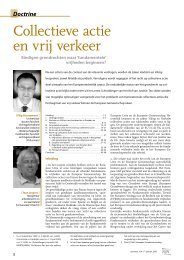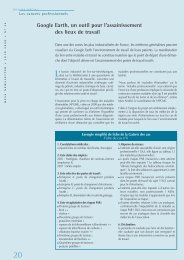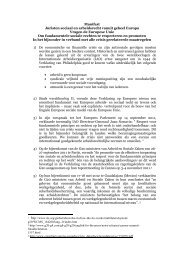Who earns minimum wages in Europe - European Trade Union ...
Who earns minimum wages in Europe - European Trade Union ...
Who earns minimum wages in Europe - European Trade Union ...
Create successful ePaper yourself
Turn your PDF publications into a flip-book with our unique Google optimized e-Paper software.
François Rycx and Stephan Kampelmann<br />
of <strong>m<strong>in</strong>imum</strong> <strong>wages</strong>. The case of Sweden illustrates this po<strong>in</strong>t: although the<br />
Swedish Kaitz <strong>in</strong>dex is relatively high compared to other <strong>Europe</strong>an countries<br />
(Neumark and Wascher (2004) estimate it at 0.52), nobody actually receives<br />
the <strong>m<strong>in</strong>imum</strong> wage <strong>in</strong> Sweden. Despite its relatively high level, the Swedish<br />
<strong>m<strong>in</strong>imum</strong> wage fails to bite due to other features of the earn<strong>in</strong>gs<br />
determ<strong>in</strong>ation <strong>in</strong> Sweden, especially the strong <strong>in</strong>cidence of collective<br />
barga<strong>in</strong><strong>in</strong>g. A complementary heuristic for the analysis of the bite of<br />
<strong>m<strong>in</strong>imum</strong> <strong>wages</strong> is to measure the “spike” of employments that are situated at<br />
or near the <strong>m<strong>in</strong>imum</strong> wage. The more employees are clustered around the<br />
<strong>m<strong>in</strong>imum</strong>, the higher is its bite.<br />
To be sure, conventional neoclassical models of the labour market do not<br />
predict any employment spikes. Accord<strong>in</strong>g to such models, the earn<strong>in</strong>gs<br />
distribution will be truncated and workers whose marg<strong>in</strong>al productivity falls<br />
below the <strong>m<strong>in</strong>imum</strong> wage will be laid off. Empirical research on wage<br />
distributions has documented, however, that this view is seriously flawed: <strong>in</strong><br />
many countries the existence of a <strong>m<strong>in</strong>imum</strong> wage has lead to visible<br />
employment spikes at or near the <strong>m<strong>in</strong>imum</strong>. Possible explanations for this<br />
phenomenon are that employers are able to afford at least part of the higher<br />
wage costs, either by tapp<strong>in</strong>g <strong>in</strong>to exist<strong>in</strong>g rents (profits) or by pass<strong>in</strong>g these<br />
costs on to consumers. An alternative explanation is that the productivity of<br />
below-<strong>m<strong>in</strong>imum</strong> employees can be raised through tra<strong>in</strong><strong>in</strong>g or organisational<br />
changes so as to make their employment profitable at the <strong>m<strong>in</strong>imum</strong> wage.<br />
Similar to the case of the Kaitz <strong>in</strong>dex, cross-country comparability requires<br />
exam<strong>in</strong><strong>in</strong>g the employment spike for similar groups of employees. For<br />
<strong>in</strong>stance, an exclusive focus on the spike <strong>in</strong> the overall wage distribution<br />
might overlook differences <strong>in</strong> employment spikes for categories such as<br />
gender, age, occupation, education, sector, etc.<br />
Depend<strong>in</strong>g on the research question, one might also be <strong>in</strong>terested by the size<br />
and characteristics of the population that is remunerated below certa<strong>in</strong><br />
threshold values, for <strong>in</strong>stance when assess<strong>in</strong>g the impact of a hypothetical rise<br />
<strong>in</strong> the <strong>m<strong>in</strong>imum</strong> wage (or the Kaitz <strong>in</strong>dex) to a higher level. Such a “shadow<br />
spike” can yield <strong>in</strong>formation on the bite of the hypothetical rise <strong>in</strong> the<br />
<strong>m<strong>in</strong>imum</strong> wage by <strong>in</strong>dicat<strong>in</strong>g how many and what types of employees would<br />
be affected <strong>in</strong> such a scenario. It should be noted, however, that the “shadow<br />
spike” can differ substantially from the employment spike that will be<br />
observed if the hypothetical <strong>m<strong>in</strong>imum</strong> wage <strong>in</strong>crease is actually implemented.<br />
The difference between the two spikes might stem from several factors: a<br />
higher <strong>m<strong>in</strong>imum</strong> wage might attract new employees <strong>in</strong>to the labour force,<br />
thereby chang<strong>in</strong>g its socio-demographic composition; conversely, some<br />
employees <strong>in</strong> the shadow spike might be laid off if the higher <strong>m<strong>in</strong>imum</strong> wage<br />
renders their employment unprofitable.<br />
20 Report 124

















